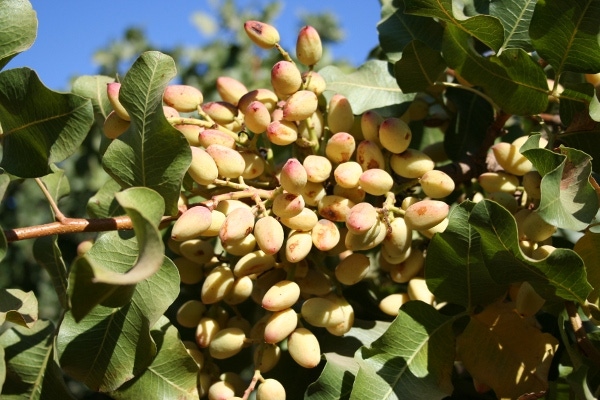January 20, 2016

Kaolin clay, typically used to guard against sunburn for trees, may also be a weapon in the struggle to combat low chilling hours that sent a shudder through the pistachio industry over the last two years.
Just as a lighter-colored house absorbs less heat than a dark-colored one, trees with kaolin clay applied absorb less heat which could help counter the lack of chilling that causes a drop in yields.
David Doll, a University of California Cooperative Extension specialist from Merced County, came up with the idea of spraying kaolin clay on trees during the dormant season to reduce radiant heat and lower the wood temperatures in order to increase chill accumulation.
He borrowed the idea from the cherry industry.
Working with Joe Coelho, a crop advisor and agronomist with Valley Orchard Management in Three Rocks, Calif., and others, Doll did a preliminary study which showed an increase in cluster count and yield.
Coelho, though cautious about waxing over-enthusiastic about the results, said he was impressed by differences he saw between treated and untreated parts of an orchard.
“There was a visual result,” Coelho said.
“We stumbled on the idea a little late last year. If we had jumped on board sooner, we might have benefited more.”
He was asked if he became a true believer in use of the clay as a solution. His reply was, “It made me believe we need to do further testing.”
And that’s exactly what will be happening in the months ahead.
At the Three Rocks site, Coelho said about nine acres were treated with the product Surround, along with dormant oil last year. In 2016, there will be nearly 23 acres treated with Surround only, and another 23 treated with Surround and oil. This will be compared to an untreated control.
Another farmer in Kern County will join the research this year.
The applications in Three Rocks came late last year, starting in January, and were made to a Kerman with Peters pistachio orchard. Coelho says three 40-pound applications were made per acre, and he suspects lower amounts might do the trick.
He says the trees retained the product well, even after heavy rains. The cost is about $1 a pound.
This year, with an El Niño looming and temperatures already dipping low, Coelho and Doll still believe it is important to press forward with applications to see how they match up with controls.
“It’s a management tool,” Doll said. “It’s not a solution.”
He added, “Applying it may not get you anything, but its insurance - a tool that can help you hedge your risk. If it’s needed, it’s there. It could potentially impact your crop - a variable that can help. There were guys who lost 90 percent of their (pistachio) crop last year.”
A difference this year is that applications began earlier – in December. Doll believes earlier applications will have still greater effects and may mean applications can be ceased sooner.
Applying into February can be problematical since it can delay bloom and result in greater vulnerability to damage from the Navel orangeworm.
Doll explained the very low chill, along with the overlap between male and female floral parts, meant more issues with trees producing blanks. Kaolin clay-treated trees in the Three Rocks plot had a higher cluster count - 50.4 clusters and 2.004 pounds per tree. Untreated trees averaged 21 clusters and 0.015 pounds per tree.
Blanking was considerably higher in untreated trees.
Temperature information collected from data loggers and sensors found an increase in chill portions from Feb. 6-20, 2015. The kaolin coated trees leafed out and bloomed 14-20 days after the untreated trees.
Doll says further study is needed to determine the correct rate and timings for kaolin application. He says applications should begin as early as late November with re-applications after rain events through late January.
It should not be applied after the first week of February unless there is a desire to delay bloom, says Doll.
“Applications may not provide a benefit and thus not be needed if the weather is cloudy, foggy, and cool,” he said.
According to Doll, the best way to apply Surround is through a sprayer on a ground rig, rather than aerially. He recommends replacing spray nozzles of ground rigs afterwards; noting that some farmers complain the material can be abrasive and wear down the orifices.
You May Also Like




